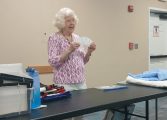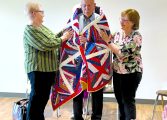Though she got a taste of weaving in high school, Charlton didn’t become passionate about it until her 30s. She took workshops in Chicago and Alexandria, Va., at a place called Springwater Weavers.
Many teach weaving for beginners but few teach beyond that level except those in a degree program for fiber arts. Charlton has taken what she’s learned and built on it. She said she has learned a lot from the way people respond to her weavings, and like a variety of artists, from those painful mistakes she has made along the way.
“I love the way that color and shapes are created by successive passes of yarn that build up slowly as the tapestry develops. It is a very slow way to create art, but it is also very relaxing and meditative,” she said. “I’m a tactile person, and I enjoy being able to feel the yarn in my hands as I weave. There is something rich and expressive about the color of a tapestry, that for me surpasses the color of the yarn on its own or even the color of other artistic media like paint; it has a depth and a texture. Yarn can also be blended in many ways to create new shades and hues that are richer than a single color.”
Charlton admitted it can take months to create a single image, and it can be very frustrating because the only way to erase a mistake is to go back and unweave it.
“When you get into the rhythm of weaving and you create a beautiful section of the tapestry it feels really fantastic,” she said.
Tapestry in its earliest art form dates back to back to the Middle Ages. Recently some valuable tapestries belonging to King Henry VIII were found in a rug shop in New York City, causing quite a stir among antiquarians. Tapestries were often used to decorate and insulate the walls of castles and palaces, and were traditionally exceptionally large. The art of tapestry was revived in the 1960s and ’70s, and the size of the pieces was still large.
“Only recently has the idea of a smaller tapestry been accepted. I enjoy the idea of reinterpreting this very traditional art form on a new scale with a different sensibility,” she said.
Charlton gets her inspiration from the landscapes around her, particularly the Fluvanna area and the Blue Ridge Mountains. She starts with a photograph of a scene that inspires her and sees if she can work it into a tapestry design. She said one of the unique things about tapestry weaving is that it can be difficult to weave certain shapes or patterns such as vertical lines, so she plans for that. She forms her plan around how she blends colors using yarn, and what scale she makes the weaving.
“I love getting out all of my yarn colors from my bins and picking out a color palate for a tapestry that I am planning,” she said. “Over the years I have built up a fairly large supply of yarn colors, although of course it always seems that I never have that exact right shade that I need for my newest tapestry.”
She has done a series of fruits and vegetables up close, including the piece that was accepted into the exhibition sponsored by the American Tapestry Alliance (ATA).
“The inspiration there was just looking carefully and up close at a familiar object to see all the nuances that are present. The tapestry that is going in to the ATA show, Persimmon, is one of those pieces. You need to notice the light and exactly how it hits each piece of the object, translate that into two dimensions, then translate that into yarn colors.”
She and her husband, Paul, have been going to this biennial event for several years but this was the first time she had the courage to enter.
“I was surprised when I was accepted and we’re going to do our best to get out to Denton or Tacoma, Wash., to see this show,” she said.
Charlton explained that the mission of the ATA is to promote an awareness of and appreciation for woven tapestries by individual artists. It sponsors two international juried exhibitions: American Tapestry Biennial and Small Tapestry International. Her work will be part of the Small Tapestry International. The exhibit focuses on small tapestries, less than 100 square inches and not more than 20 inches in any one dimension.
“The idea is to explore and celebrate tapestries in a small format, which create an intimate experience with the viewer just as well as large, traditional tapestries that often fill walls,” she said.
It is up to the artist to interpret the theme in their work, Charlton said. The theme refers to crossed weft and warp. It examines the role of tapestry artists in today’s technologically advanced society and how the ancient medium can be used in a significant way. Weavers explore their art form through the crossroads of warp and weft.




